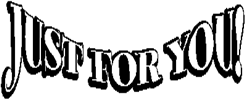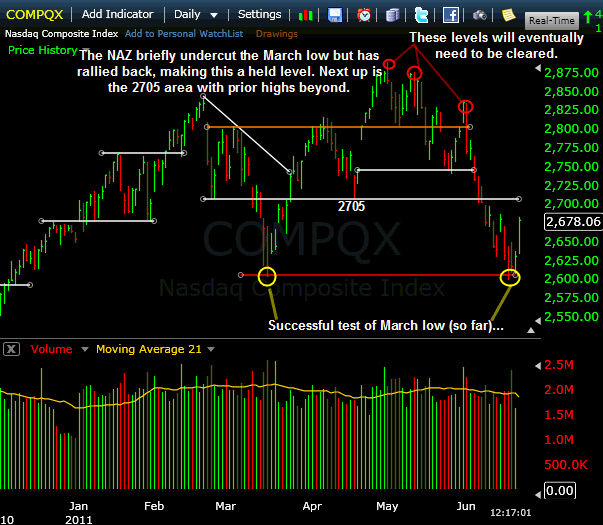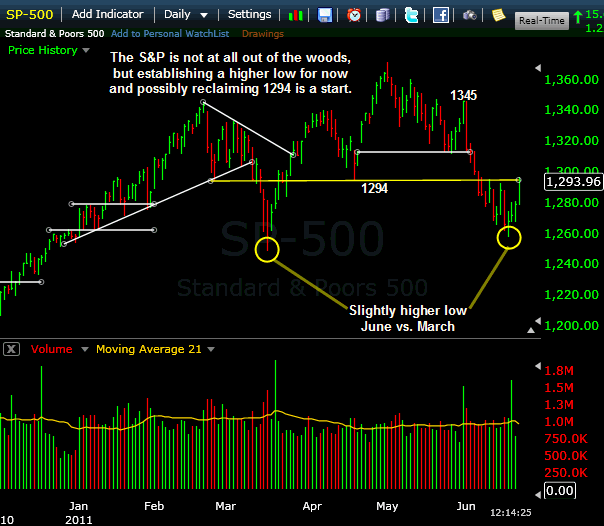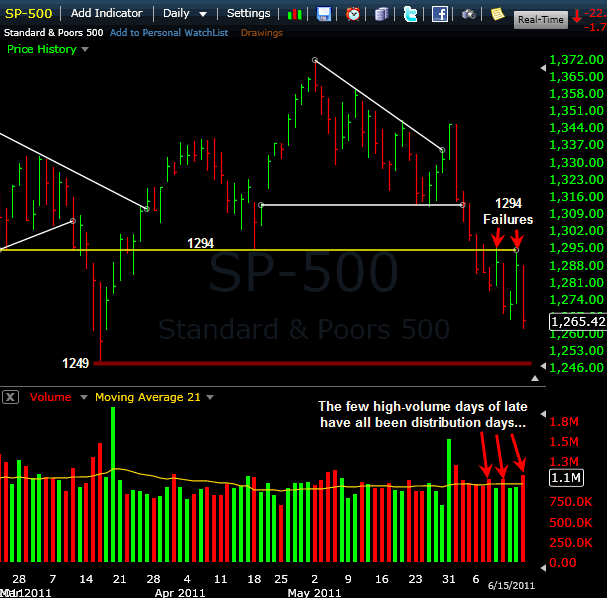Be Imperfect!
June 24, 2011 at 9:43 am
 Society trains us to want to be perfect. And in many endeavors, that’s something worth striving for. Surgeons, for example, can put you at ease when they tell you they’ve performed this operation hundreds of times without any problems. Students with perfect grades get academic scholarships, saving boatloads of tuition money. And the list of examples of the benefits of perfection goes on and on.
Society trains us to want to be perfect. And in many endeavors, that’s something worth striving for. Surgeons, for example, can put you at ease when they tell you they’ve performed this operation hundreds of times without any problems. Students with perfect grades get academic scholarships, saving boatloads of tuition money. And the list of examples of the benefits of perfection goes on and on.
From our appearance to our performance, someone else will always be a little better, and it causes us to try to perfect whatever it is we’re doing for the sake of improvement (or keeping up). Unfortunately, it carries over into our trading – much to our detriment.
You see, when it comes to trading, there’s no room on the perfection list. And that’s a good thing, because perfection isn’t required for success.
The very worst traders try to be perfect. They either stay sidelined in search of a perfect strategy (backtesting galore), or they practice trade until they make $1M in hopes of duplicating it live, or they simply refuse to lose.
Perfection in trading is paralyzing, both to you and your account. Growth is prevented, confidence suffers, and you feed the very traits you should strive to shun.
I’ve said before that in trading, you succeed by not failing. But that doesn’t mean you can’t have failed trades – quite the contrary. Expect losses! As negative as that might sound, it will mentally prepare you to accept them gracefully and move on to the next trade which might be a far bigger winner).
The best traders are imperfect – by choice. They grow from mistakes, not successes. Lose small and face the music when your current approach isn’t working. That shows true confidence. By definition, imperfection brings opportunities for growth – both in your account (lose small and win bigger) and in your abilities as a trader (learn new methods). But you’ll miss out if you’re not willing to bend.
Trade Like a Bandit!
Jeff White
Producer of The Bandit Broadcast
How Traders Get a Raise
June 22, 2011 at 11:56 am
 Every business has overhead (some more than others), and although you may not have a brick-and-mortar storefront, you certainly have overhead as a trader.
Every business has overhead (some more than others), and although you may not have a brick-and-mortar storefront, you certainly have overhead as a trader.
It’s business 101 that to make more money, you either bring in more revenue or you fatten your profit margin by cutting costs. Plenty of posts on this blog discuss ways to accomplish the former, but today, we’ll talk about the fastest way to achieve the latter.
The Elephant in the Room
Traders rarely stop to consider the biggest expense they face, which is usually commission costs. The fees we pay to enter and exit trades are no doubt a cost of doing business, but once you’ve hit a certain experience level with your trading, it’s likely that your attention has diverted to strategy and execution (which is fine). By default, however, you’ve ignored one expense which can easily run into the mid 5 figures over the course of the year if you’re an active trader.
Even if that’s not the case with you, it’s still worth taking note of just how much you’re paying on commissions. Newbie traders recognize this when they come to the market with small accounts, and they soon realize that they’ll need a sizeable move in the stock just to overcome their costs.
Regardless of your situation, take heart! There is a solution…
NEGOTIATE YOUR COMMISSIONS!
Aside from why you should do this, here are a few reasons why you can do this…
Apples to Apples. Transaction costs have come down tremendously in recent years for everyone. Technology has greatly improved, which isn’t cheap, but the fact is that when it comes to the standard trading platform features, virtually everyone has similar technology. Occasionally you’ll find something very unique, but you can most likely accomplish your trading on a variety of platforms, which means you aren’t tied down to any single brokerage. They know this.
Move the Line. Every brokerage has the capability to lower your commissions. So, get creative if you need to. Work the numbers and find out if there’s a threshold you need to meet in terms of monthly trading volume in order to get an improved rate. Find out if they’ll waive your platform fee (if you pay one) at a certain level, or switch from a per-trade to a per-share commission structure.
The Advertised Rate is a Starting Point. The displayed homepage commission price which brokerages show is a number most people will gladly pay, but it doesn’t have to be “the” number. And the more active you are as a trader, the more you should view it as simply a starting point for negotiations. Every brokerage knows their margins, and they know the rock-bottom price which they can offer. I can guarantee you that’s not their advertised rate. They have room to move, and often all it takes is simply knowing you can ask for something a little lower. And while these are certainly not used-car salesmen, the same principle applies…if they let you walk away, then they really can’t deliver the price you’re asking for.
Competition Abounds. Brokers are highly competitive and motivated to get your account, and they know there’s lots of turnover in the industry. That means they can lure you away from your current firm, but it also means if they don’t retain your business you’ll go elsewhere. So if you’re looking for a new platform to trade on and you’re hunting brokers, ask for a reduced rate. Odds are, if you find it offered elsewhere, you can get that rate matched. And even if you’ve been with your current brokerage for quite a while, there’s no harm in asking for a lower commission rate. Remember, if they don’t keep you, someone else will earn your business, and they don’t want to lose you.
You don’t have to be a smooth talker to pull this off. Call up your broker and ask what they can offer you. Worst case, they tell you no and you’re exactly where you are now. But in many cases, you’ll be able to cut down your transaction costs, which can lead to a big pile of money by the end of the year. How is that not worth asking for?
Trade Like a Bandit!
Jeff White
Producer of The Bandit Broadcast
Two Ranges to Watch
June 21, 2011 at 11:28 am
Last week we saw an important test of the March lows in the NAZ and RUT, while the S&P 500 held slightly above support from the spring. Those March lows give us a well-defined area to trade against, even if it’s a long way back up to the May highs. Stated otherwise, we may have just carved out the low end of a very wide range.
But that’s not the only range found in this market. We also have the NAZ caught between the 2700 area (late-Feb low & mid-April low) and the 2600 area. It’s working its way back up toward 2700, so the key will be if that level can be reclaimed on a closing basis.
Here’s a look at the NAZ, including both the wide and narrower ranges previously mentioned:
The S&P 500 has a slightly different situation here as it held above the March low and is currently flirting with the 1294 area which has proven important. We saw the late-Feb selloff end at that level, as well as the mid-April pullback finding support at 1294. More recently, that level was broken on June 6 and has yet to be reclaimed on a closing basis. A push back up through there could certainly help this index, although it still has plenty of rebuilding work to do. It has a higher intermediate-term low in place for now (June vs. March), but still stands a considerable distance from prior bounce levels (most notably 1345 from May 31).
Here’s a look at the S&P 500 chart along with the noteworthy levels right now:
Needless to say, this market remains interesting and there should be no shortage of movement going forward.
On another note, the premium newsletter turns 7 today, so for those of you who are members and have stuck around from the beginning in 2004, we appreciate you and remain committed to providing ongoing, exceptional value which adds to your trading process!
Trade Like a Bandit!
Jeff White
Producer of The Bandit Broadcast
Caught In A Trap
June 16, 2011 at 5:44 am
Anytime the market tanks like it has lately, astute traders realize that shorting after a decline of this magnitude and momentum is a real potential bear trap. A sharp rebound could come at any time, leaving late shorts in a world of hurt.
I can’t and won’t argue with that – in the short term.
But the further this market declines in the intermediate term, the growing group of trapped traders are the bulls. Keep in mind that the past few weeks have been a big shift of character for this market, with the prevailing mantra moving from buy-all-dips to sell-all-rallies. Technically, that’s very important to recognize.
And while a sizeable bounce will eventually arrive, the important issue for most bulls is “from what level?”
Head Games
That brings into play the psychological aspect of this change of character, whereby not only do bulls become fearful, but the bears gain confidence. Bulls who bought virtually anytime over the past few months are now underwater, and the deeper this correction goes, the more that late-to-the-rally-party group wants out.
That could quite easily play out with bulls selling on the way back up – just the opposite of a few weeks ago when trapped bears covered on every little dip. By the same token, just as a few weeks ago we were still seeing underinvested or aggressive bulls put more cash to work on even minor pullbacks, the deeper this correction goes, the more the bears will be using bounces to remount short positions. That means what used to be buying by both camps is quickly morphing into selling by both camps.
A spring back up will at some point arrive, so fear not – this market is still a 2-way street. But for now, respect for the tape should remain very high, because anything is still possible. Whenever the inevitable recoil of this selloff kicks in, keep in mind that it too could get faded, and therefore will have to earn your trust.
Here’s a look at the S&P right now with the March lows coming quickly into view at 1249 (which may need to get broken before a real bounce happens):
Trade Like a Bandit!
Jeff White
Producer of The Bandit Broadcast
YOUR Trading Plan, Part 3
June 15, 2011 at 7:52 am
 In Part 1 we discussed the importance of discovering YOU. In Part 2, we looked at the need for defining risk so that you know “the number” for every trade you make.
In Part 1 we discussed the importance of discovering YOU. In Part 2, we looked at the need for defining risk so that you know “the number” for every trade you make.
Here in Part 3, let’s see what the remaining process might look like.
Playing Favorites
In accordance with what you’ve already discovered about yourself, the first step in the next phase is to identify 3-5 patterns you’re comfortable trading. This chart pattern page is a great starting point. Pick out a few you think you can locate with ease, and you can always build or add more later. The aim is to master a few plays which you can rely on, and then build more into your arsenal later.
Next, set up some watch lists for each of those patterns. Add stocks into the appropriate list (ex: ascending triangle candidates) and remove them when they fail to meet the designated criteria. Filter out low-priced stocks or thinly traded issues (I prefer to avoid stocks with daily average volume below 500,000 shares). This is just another way to narrow down your list. Draw trend lines when necessary, and make notes when you see important technical events unfolding. My stock newsletter highlights actionable ideas with identifiable patterns nightly which you may be seeking. But regardless of where you get ideas, the point here is to cultivate them on an ongoing basis.
At this point, it’s time to eliminate stocks which misbehave. These are stocks which gap frequently, or which tend to make sudden, adverse moves, or which have a history of breakout failures immediately after clearing resistance levels. Some stocks my either be too volatile or too sluggish for your liking, so get rid of them. It’s up to you, but by studying your lists closely on a regular basis, you’ll identify certain “personalities” which seem to jive better with you than others, and again this will narrow down your list by eliminating those which are not a fit.
All About Priorities
Finally, designate a way to prioritize plays. It might be the pattern itself (maybe you like ___ pattern better than ___ pattern). Or maybe it’s a certain price range preference (ex: you might like stocks in their $30’s better than single-digit stocks). It may be based upon the cleanness of the pattern – for me this is important. I like cleaner patterns, just because they are that much more concise on when I should be IN vs. OUT of the trade.
Whatever you choose, have a hierarchy for which plays you seem to do better with than others, as this will help you narrow down *your* trades without putting you into the first 25 stocks you see. It’ll also help you decide which plays to hold onto and which plays to rotate out of when you see a more fitting opportunity for your capital.
CONSISTENCY is the key. The actual selection you make isn’t nearly as crucial as many think. It’s more important to be decisive and pick one and manage it properly than it is to flip/flop between one strategy and another. The success comes in having a plan and putting it to work over and over through time, like a batter knowing he’ll have 1000 at-bats. You want to eliminate errors, and those largely come from indecision and inconsistency, like swinging at pitches outside of your hitting zone.
I hope this series has been helpful to you and has answered some lingering questions which pertain to your unique situation. There IS a trading style for you, but you have to ask the right questions, put the right kinds of plays into your routine, and then consistently execute the plan you’ve set forth.
Should you need additional coaching or assistance for your trading, contact me and I’ll be glad to show you several solutions.
Trade Like a Bandit!
Jeff White
Producer of The Bandit Broadcast
YOUR Trading Plan, Part 2
June 14, 2011 at 9:36 am
 In Part 1, I put forth some questions that need to be answered by you in order to move forward with any lasting effect. Those help you identify what it is you’re after, what styles you should pursue, and which approaches you should completely avoid. Let’s proceed.
In Part 1, I put forth some questions that need to be answered by you in order to move forward with any lasting effect. Those help you identify what it is you’re after, what styles you should pursue, and which approaches you should completely avoid. Let’s proceed.
Start With the Basics
Understanding your preferences, biases, needs and availabilities will clarify your basic approach.
For example, if you were trading a retirement account (non-margin, and thus no short selling, and you prefer the long side and capturing segments of uptrends, you’ve got a starting point. You might narrow your focus to a long-only style based on patterns such as resistance breakouts, as well as bullish continuation patterns like bull flags, bull pennants, and ascending triangles. Those are easily identifiable patterns, which is nice, so you should have a steady flow of candidates to suit your needs.
See what I meant in Part 1 when I said trading allows you a custom-designed approach?
Go Big AND Go Home
Next, decide on a risk amount per trade, in terms of potential dollar loss – not in terms of cash outlay. Think in terms of “real risk” or what you’re truly risking before exiting on the downside. This is the amount you’re willing to lose if/when you are wrong.
That sounds negative, but it’s crucial. Whether it’s $200 or $500 or $5,000 doesn’t matter, so long as it’s a suitable amount of risk for your unique situation. The amount itself is of secondary importance to simply having an amount. It’s a starting point for every trade.
Too many traders fail to begin with an amount of risk they can stomach, and they trade too big and pay the price. That’s no good, so always aim to trade within your means so you can survive and make good decisions.
For example, let’s say your risk amount is $200 per trade. This is what you’re willing and able to risk (lose) if the play doesn’t work out.
So take a trade in XYZ with a pattern that suits you, like an ascending triangle pattern. A breakout might be at $18, and a failure might be at $16. So you could go long this hypothetical trade at $18 with a $16 stop. That’s a $2 per share stop, and you’ll risk $200 per trade, so you could buy 100 shares. Easy math. It doesn’t have to be complicated to be helpful to your trading.
See how knowing *the number* for you can help you understand how much to be trading? The strategy itself is based on the pattern confirmation (entry) or failure (stop loss), but your position size comes down to what you’ll risk per trade. Few traders incorporate this into their plan, but if they did, they’d be miles ahead and avoid many painful trading disasters as well.
In part 3, I’ll wrap this up with some specifics for your overall process. Until then, decide on some basics which suit you and figure out your ‘number.’
Trade Like a Bandit!
Jeff White
Producer of The Bandit Broadcast
YOUR Trading Plan, Part 1
June 13, 2011 at 12:42 pm
 You are unique (and you don’t need me to tell you that). The desire to find a trading plan that’s right for YOU is of paramount importance, because we are all a little different.
You are unique (and you don’t need me to tell you that). The desire to find a trading plan that’s right for YOU is of paramount importance, because we are all a little different.
When it comes to your chosen trading methodology, you need to determine a number of things about yourself before going forward. These are things like your trading timeframe, risk tolerance, directional bias, and desired setups to pursue.
That’s the beauty of trading, you know. The market offers you the ability to custom-design an approach that works for YOU. Ask yourself questions such as…
* Will you be day trading for smaller but more frequent profits, or will you be entering positions for several days or weeks?
* Will you be comfortable keeping tight stops of just a few percent, or are you comfortable allowing more breathing room for trades in order to reach a more distant profit objective?
* Are you comfortable short selling, or do you prefer to only buy stocks?
* Are there specific patterns which you really like to trade or have found success with, such as buying dips within uptrends or perhaps buying breakouts?
These kinds of questions which can only be answered by you, but you MUST determine those answers in order to be effective. Those answers are paramount to your finding the proper strategy for YOU. I cannot emphasize that enough. Otherwise, you’ll be chasing different strategies by the day, but never knowing what’s working best and what to completely avoid. And if you’re dabbling in strategies which don’t suit you, you will not trust them or commit to them.
So when it comes to your trading plan, the more clear you can be on who you are, the more clearly you can define what it is you should be trading – and (equally important) what you should NOT be trading. That last part gets many traders in trouble, they stray into unfamiliar territory and find themselves making poor decisions which prove costly.
Since this is Part 1, there’s obviously more to come. But before the next part arrives, you have some homework to do – answer those questions above. I don’t want to know the answers to them, but you’re going to need them. Otherwise, the info to follow will carry no significance to you, rendering your time (and mine) completely wasted. Don’t be “that guy!”
I’ll see you in Part 2.
Trade Like a Bandit!
Jeff White
Producer of The Bandit Broadcast








